Delaware River Connections Mural
- Meg Lemieur

- Jul 14, 2025
- 5 min read

This year I was asked to create a mural through Mural Arts for State Rep Joe Hohenstein’s office in Bridesburg, which is a neighborhood located about 6 miles north of Center City, Philadelphia. He wanted a mural that celebrated the Lenape people and the Delaware River. Right up my alley! The Tacony LAB Community Arts Center, run by Mural Arts and Project Manager Barb Baur, tapped me to work on this and I'm delighted they did.
In our initial meeting with community stakeholders, we talked about how Bridesburg has been virtually cut off from the river for generations by a strip of heavy industry along the waterfront. But neighbors have always found a way to sneak down to the river’s edge to fish and spend time with friends. Recently, there has been a push to open up access to the riverbanks. In Bridesburg, this has led to the opening of the K&T trail and the all new Borski Park, which opened this month! So this mural, welcoming people back to the river, is going up at exactly the right time.

Trinity Norwood of the Nanticoke Lenape Nation worked with me to conceptualize the initial design idea. She talked about how the river connects us across borders, generations, nationalities, with our ancestors and descendants. I visualized these thoughts through the main Lenape character’s stance, opening her arms to welcome people and wildlife back to the river. The Lenape person is wearing a ribbon skirt, which is traditional. The ribbon colors are red, white, yellow and black- the colors of the Medicine Wheel. This is not only significant to Lenape ceremonies but also represents different phases of life, connecting us intergenerationally. The turkey, wolf, and turtle represent the three original Lenape clans. The floral design is in the same style as local Lenape fashion design elements. The red shirt is a connection to the advocacy around Missing and Murdered Indigenous Women.
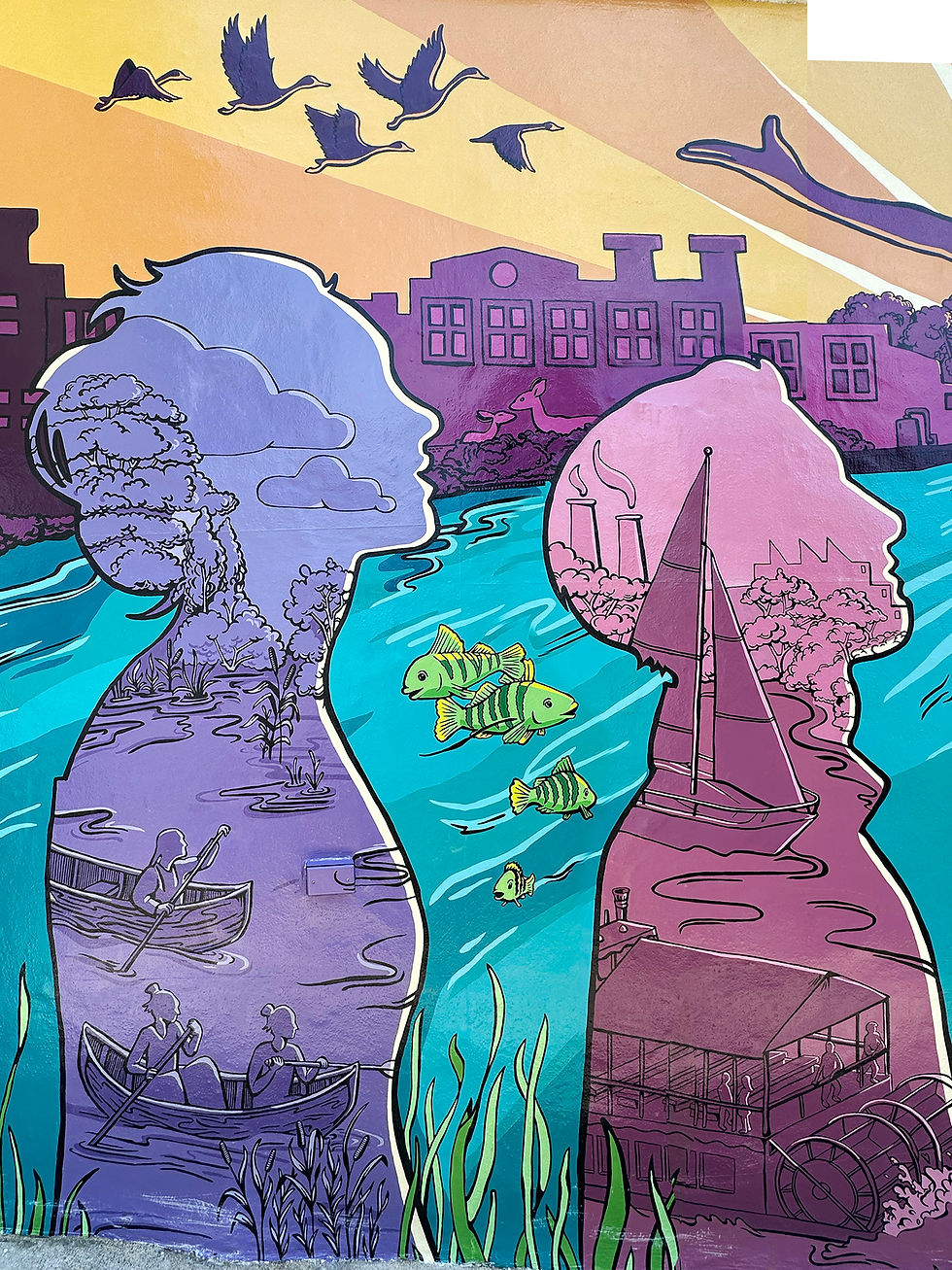
The four silhouetted people that look up to the central figure represent the current population of the Bridesburg neighborhood. There is a large Polish and German population along with Latinx and Black folks. Before European contact, this area was populated by the Lenape Nation. Within each of the figures are scenes from different time periods highlighting human connections with the river.
Within the purple figure, we see a pre-colonial scene with a pristine riverbank and Lenape folks paddling the river in canoes. I included native cattails here, which are an indicator species, especially for wetlands. That means that their presence can identify an area with nutrient-rich soils and clean water.
The pink figure has a industrial-age scene with active smokestacks and factories along the river’s edge, a sailboat, and a historic paddle ferry- something I was pleasantly surprised to learn that would travel between PA and NJ.

Within the green figure is a modern-day scene. A father and daughter fish in the river as a huge barge glides by with the Tacony-Palmyra bridge in the background. Mallard ducks are ever present along the river, so I let them have their moment here.
The orange figure holds a scene of hope for the future. In our community engagement meeting for this mural project, I learned about a dock nearby that used to host small live music shows. In that meeting, we all agreed that this would be a wonderful thing to see active again in the future as access to the river becomes more common. The musical notes floating into the sky are from a WW2-era Polish ballad called “Deszcze Niespokojne.” I also included an Atlantic Sturgeon and a Shad fish in this scene. As the Delaware hopefully becomes cleaner and cleaner, a strong return of these fish populations would be a great indicator that we are doing right by the river.
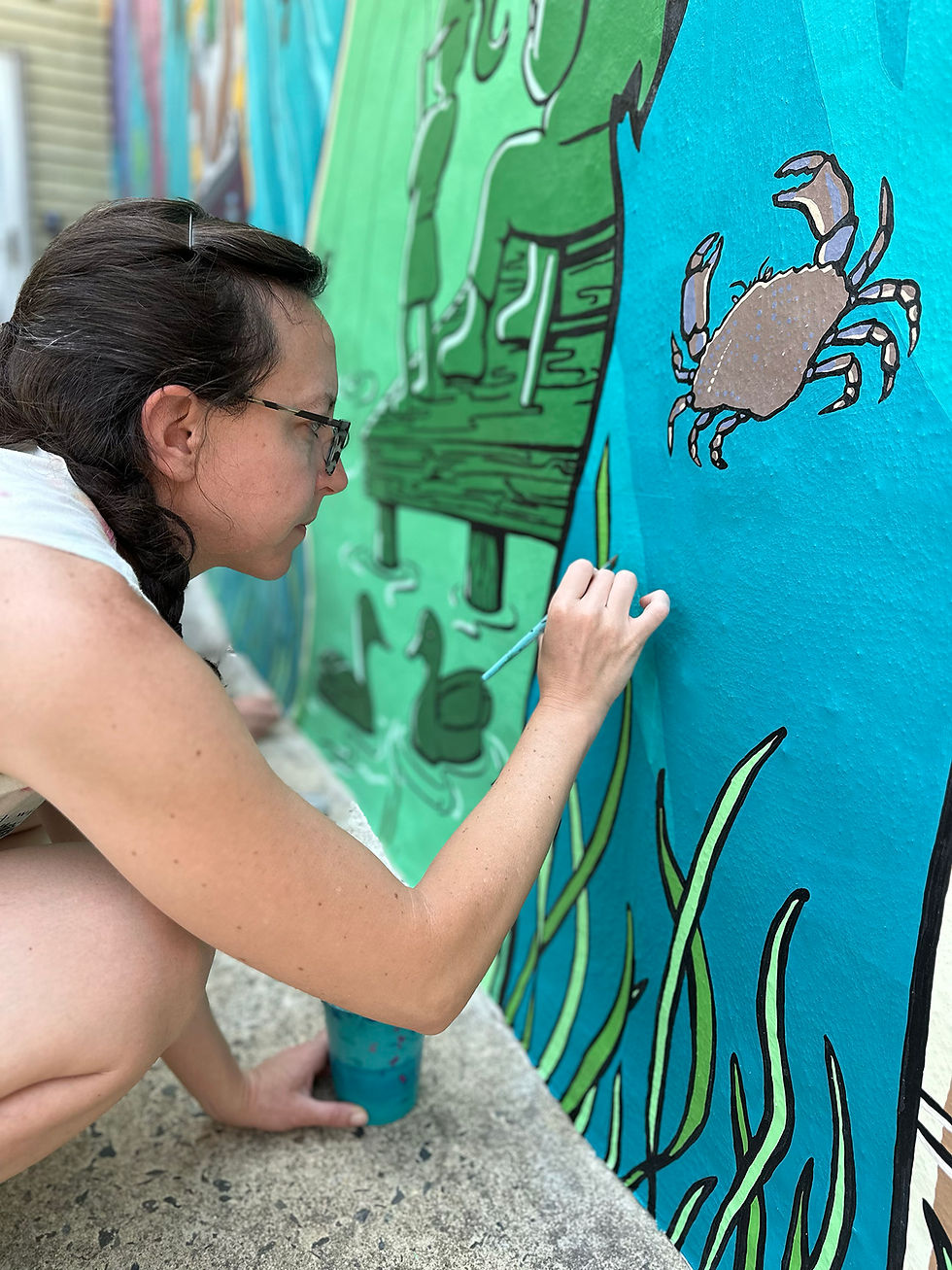
The animals in the background of the mural are White-tailed Deer, Perch fish, Box Turtles, American Beaver, and Rock Crab, Canadian Geese, Great Blue Heron, and Swifts- all common animals in our Riverwards neighborhoods here in Philly.
The making of this mural was fast and meticulous. The overall design came to me while I was sitting in our initial stakeholder meeting, listening to everyone’s stories. I quickly sketched out the idea and showed the group, who immediately recognized how their stories could be represented within the design. I’m glad that group is full of imaginative and trusting people because that sketch was rough! I went home and drew it up nicely after that.

We held a community engagement meeting to present the mural concept to the neighborhood and gather fun details about Bridesburg’s relationship with the Delaware that I was able to include in the final design.
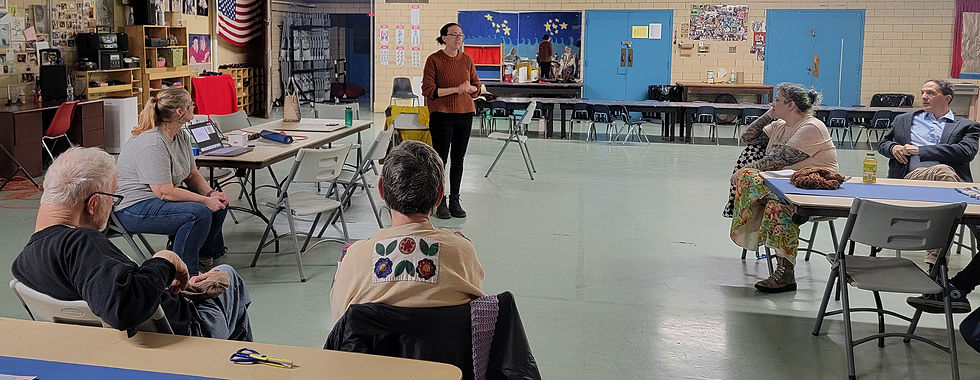
In my work, I love to add details to my larger illustrations and had to stop myself from adding so so much more. I bounced my drawings off of Trinity over a couple of beers, resulting in slight adjustments that made the piece work even better. We then sent the design off to Mural Arts headquarters and had a Design Review. The reviewers had great questions and ultimately encouraged me to highlight the Lenape person as much as my design would allow.
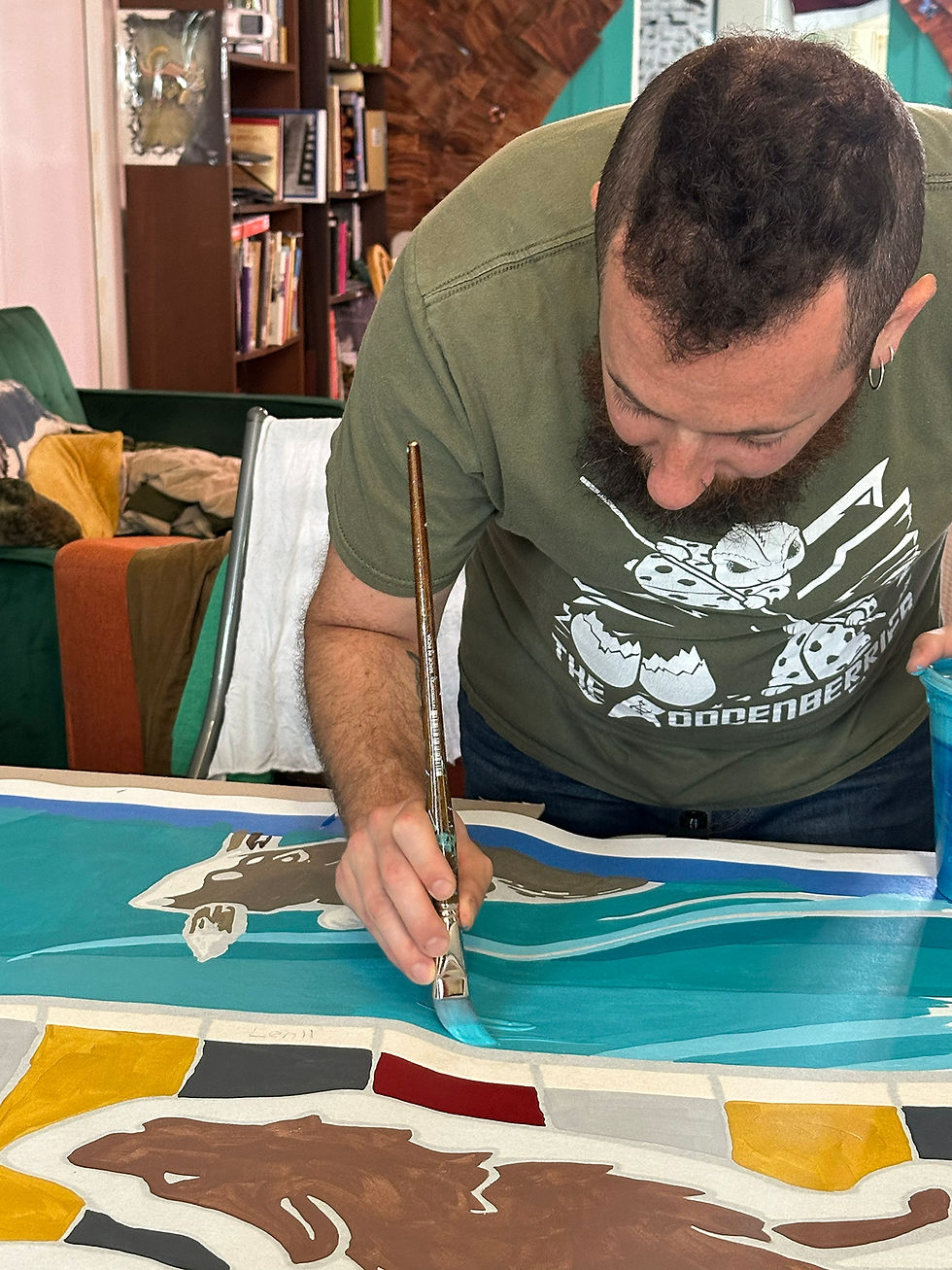
Next came the painting. The process we used was to print a half-opacity version of the design large sheets of Polytab, a primed fabric blend. My mural assistant Cody and I mixed the 63 paint colors that were in the design.
This project was a solid reminder that painting murals takes much much longer than most of my illustrations. Cody and my ever-supportive partner Andrew took charge of painting large portions to make sure we got done on time.
Tucked within our month of intense painting, we hosted a Community Paint Day where Bridesburg neighbors came out to brush on a layer of paint to our panels. These events are important for the mural process because it gives neighbors an opportunity to feel true ownership over the design. The more connected the people around the mural feel to it, the better they will take care of it over its lifetime. Emotional connection is something we want to foster for all murals. It’s also a great way to get the first layer of paint down!
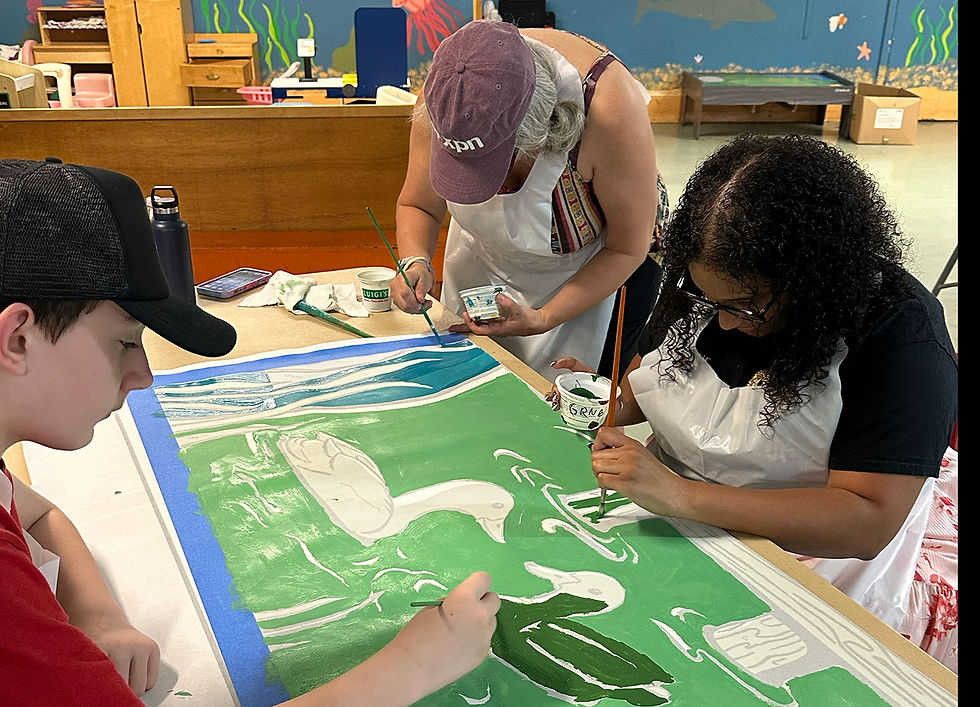
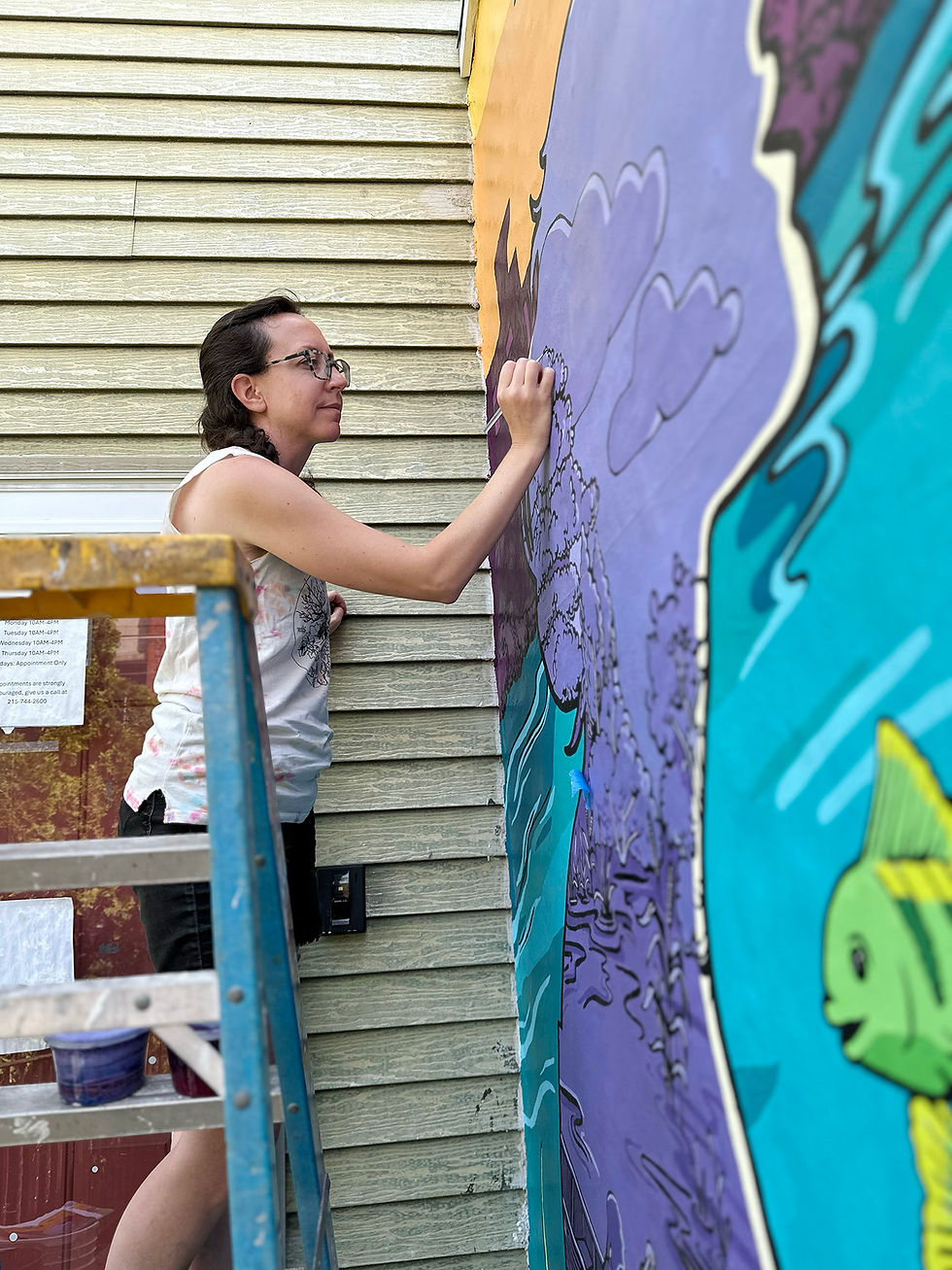
Our installation took 2.5 days and we were lucky to miss storms and extreme heat waves in the middle of a Philly summer with a lot of both. Cody headed up the whole process, showing me the ropes and never waning in his energy. To be honest, installing the panels was far more physically rigorous than I expected. Or maybe it just felt like that because of the heat and humidity. Either way, I'm glad Cody was there to make sure the job got done so well. It is basically like wheat pasting, but with 5’x5’ sheets that have to be perfectly flush to the wall and perfectly pasted and perfectly placed. Once all 18 panels were on the wall, we took about 8 hours to do paint touch ups- covering up seems and little areas where the paint had been knocked off during the installation process, and blending the edges into the stucco wall. We sealed the whole thing twice in a mural sealant.
And then we had ice cream.
We will have a mural dedication at some point this summer, but you can go see it whenever you would like at 4725 Richmond Street, Philadelphia, PA 19137.



With a Bachelor’s in Fashion Design and a Master’s in Styling from London, Sadhna Vibha Reddy has been passionate about creating designs since childhood. Inspired by India’s rich textile heritage, she envisioned a brand that blends comfort, sustainability, and artistry. https://refyndcasual.com/collections/mens-clothing https://refyndcasual.com/collections/shop-all